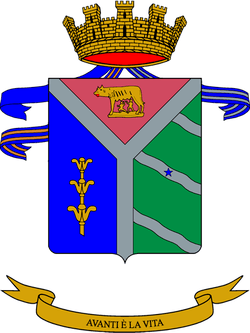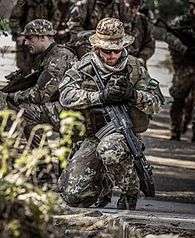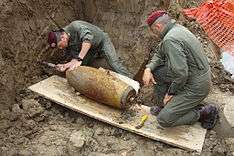8th Paratroopers Engineers Regiment (Italy)
| 8th Paratroopers Engineers Regiment "Folgore" | |
|---|---|
 | |
| Active |
20 Oct. 1926 - 8 Sep. 1943 11 Sep. 1992 - 30 Nov. 1995 13 Oct. 2004 - Present |
| Country |
|
| Branch |
|
| Type | Regiment |
| Role | Paratrooper, Combat engineer |
| Part of |
|
| Garrison/HQ | "D. Briscese" in Legnago, Province of Verona Italy |
| Patron | Saint Michael |
| Motto(s) | Avanti è la vita (Life Ahead) |
| March | Allarmi arditi dell'aria |
| Engagements |
Military operations other than war
|
| Commanders | |
| Current commander | Colonel Domenico D'Ortenzi |
| Insignia | |
| Maroon Beret (Basco Amaranto)= |
 |
| service identification badge= |
 |
| combat Service Identification Badge= |
|
| Italian wings= |
 |
The 8th Paratroopers Engineers Regiment "Folgore" (8° Reggimento Guastatori Paracadutisti) is the unique and special unit manned by para combat engineers belonging to the Italian Army which exists to provide close combat support to the Paratroopers Brigade Folgore. For this reason it is fully manned, able to deploy with a very short notice and fighting in every environment, either permissive and nonpermissive one. In peacetime it is continuously involved in supporting civil population disposing explosive remnants of war or other explosive devices, normally in support of police forces, and in case of natural disaster.
History
The combat engineer speciality was first born in Germany with the name of pionier. After the astonishing results obtained by those special engineers in the Ardenne region during the Battle of France (1940), Italy decided to create its own pionier which were named guastatori. Starting from 1940, the most offensive, strongest and bravest willing engineers were sent to Civitavecchia Assault Engineer School to attend the guastatori course. They were trained to approach enemy strong points and fortifications, place explosive charges to get the most effective results (slots, doors, air ducts), waiting for the explosion a few meters close to the charge and then, supported by assault weapons (such as machine guns, light mortars, flamethrower and offensive hand granades), break into the just opened breach. Pre-conditions for the success were: surprise, temerity, bravery, planning, synchronization and memento.[1]
The Combat Engineers were organized in companies which were subsequently collected in battalions. The basic combat element was the platoon made up of two destruction teams (equipped with rifles, hand grenades, smoke sticks and bangalore torpedoes to open corridors and special charges to destroy fortifications) and two support teams (equipped with heavy machine guns and light mortars). This platoon was considered able to successfully strike a fortification with three or four active positions.[1]
For parachute and alpine divisions were created and trained special assault engineer companies and battalions.[1]
8th Engineers Regiment
The origins of the Regiment go back to the 8th Engineers Regiment (8° Reggimento Genio) of the Royal Army (Regio Esercito) which was constituted in Rome on 20 October 1926 for the renaming of the 7th Engineer Regiment (7° Reggimento Genio). The engineer battalions belonging to the 8th Engineer Regiment were deployed to Italian East Africa and fought in all of the Italian fronts during the World War II. The regiment was disbanded on 8 September 1943, the date on which the Armistice of Cassibile was made public.[2]
Then the regiment was reconstituted on 11 September 1992 in Villa Vicentina, Province of Udine, from the transformation of the 184th Combat Engineer Battalion "Santerno". It participated in the Italian "Pelican Operation" aimed at stabilising Albania but afterwards was again disbanded on 30 November 1995 due to a reorganisation which involved the Italian Army.[2]
8th Paratroopers Engineers Battalion

The 8th Paratroopers Engineers Battalion (motto: Rompo, Dirompo, Irrompo), operational and deployable part of the regiment, was born in Tarquinia (Province of Viterbo) in the first months of 1940 as an infantry unit made up of three rifle companies, 22nd, 23rd and 24th, plus headquarters company. Once the parachute training was completed, the battalion was initially assigned to the 3rd Parachute Regiment (3º Reggimento Paracadutisti). In May 1942 it moved to Civitavecchia (Province of Rome) where parachutists attended the Assault Engineer Course (corso guastatori). The course was usually attended by engineers only but, due to the urgent requirement of the Italian Army to have the parachute division available to launch an air assault operation on Malta and the concomitant unavailability of engineers, it was decided to train infantrymen. Afterwards, the just qualified Guastatori of the 8th Parachute Battalion were sent to Bagnoli (Province of Naples) where they attended the course held by the German Engineers.
The 1st Paratroopers Division (1ª Divisione Paracadutisti) was born on 1 September 1941. It was constituted, in addition to the divisional support entities, of the 1st, 2nd and 3rd Parachute Regiments (1º, 2º and 3º Reggimento Paracadutisti), the Parachute Artillery Regiment (Reggimento di Artiglieria Paracadutisti) and the 8th Paratroopers Engineers Battalion (8° Battaglione Guastatori Paracadutisti). In June 1942 the division was named "Folgore" and was deployed to Northern Africa to sustain the Axis war effort. The battalion (minus the 23rd Company which stayed in Italy with other units of the "Folgore" to train the constituting 2nd Parachute Division, "Nembo", fought on the Northern African front until the Battle of El Alamein commanded by its first commander, Major Giulio Burzi, a hero of World War I awarded with the Italian Silver Medal of Military Valor. The unit, invicta as the rest of "Folgore", remaining of a few dozen parachutists, withdrew in order as vanguard to protect the rest of the survived soldiers. But the story could not finish with that.

The very few parachutists who survived the Northern African Campaign who succeeded to move back to their homeland, belonging to the 8th and not captured by the enemies, the 23rd and the re-constituted 22nd and 24th, gave a new life to the battalion which was also called 8th the Second (8° Bis) and was assigned to the 185th Parachute Regiment - former 1st (185° Reggimento Paracadutisti - ex 1°), "Nembo", constituted in Pisa on 1 November 1942.[3]
But this time the parachutists did not attend the Combat Engineer Course (corso guastatori) but stayed fusiliers. In fact the engineer support to the 184th Airborne Division "Nembo" was granted by the CLXXXIV Parachute Assault Engineer Battalion which will gain honor and fame in combat after the Armistice of Cassibile fighting with the Allies in the Italian Italian liberation corps, and particularly during the battle of Filottrano Province of Ancona (July 1944).
In 1943, while the main body of the 184th Airborne Division "Nembo", CLXXXIV Paratroopers Engineers Battalion included, was ordered to deploy to Sardinia to fight as defensive force,[4] the 185th Parachute Regiment and the 8th (bis) Parachute Battalion with it, played detached by its Division a different role. In July 1943, the 185th was first deployed to Apulia to protect local airports, then moved to Calabria and finally to Sicily, to fight the allied invasion and the advance to Messina.
After tough clashes fought in vicinity of Barcellona Pozzo di Gotto, Castroreale and on the foot of Peloritani, which were the last positions of the defensive line Messina, the Regiment was forced to withdraw by the Allies in direction of Messina first and to ferry to the continent later. The fight continued in Calabria in the country and on Aspromonte but for the 8th (bis) it incredibly finished at the dawn of 8 September. That morning, on Zillastro plan, just a few hours before the declaration of the armistice, the battalion, trying to break the possible encirclement, struck the more numerous enemies, the Canadian "Nova Scotia" and "Edmonton"; at the end of the battle, after very hard melee, the parachutists were defeated and the 8º Battalion got out of the roster of the Regio Esercito.[5]
On 1 June 2001 the 8th Paratroopers Engineers Battalion was officially reconstituted in Legnago province of Verona, once again under the adored "Folgore" as it was in origin. This time the battalion was made up of 4 combat engineer companies (instead of 3), plus the logistic support company. Then it was decided to reconstitute the three companies with their historical names 22nd, 23rd e 24th. In addition, for the 4th, it was decided to name it 21st, in honor of the company already belonged to the 7th Paratroopers Battalion, which fought close and with the 8th within the Ruspoli Group during the Battle of El Alamein.
The commanders:[6]
| Rank | Name | Start | Finish |
| Ten.Col. | M.A.V.M. Giulio Burzi | 1941 | 1942 |
| Cap. | Gianfranco Conati | 1942 | 1943 |
| Ten.Col. | Scala Massimo | 2000 | 2001 |
| Ten.Col. | Fanni Maurizio | 2001 | 2002 |
| Ten.Col. | Stella Vittorio Antonio | 2002 | 2003 |
| Ten.Col. | Vecchio Vincenzo | 2003 | 2004 |
| Ten.Col. | Tummina Salvatore | 2004 | 2006 |
| Ten.Col. | Scaratti Pierluigi | 2006 | 2007 |
| Ten.Col. | Varesano Pasquale | 2007 | 2008 |
| Ten.Col. | Romano Salvatore | 2008 | 2009 |
| Ten.Col. | D'Ortenzi Domenico | 2009 | 2010 |
| Ten.Col. | Fucci Fabio | 2010 | 2012 |
| Ten.Col. | D'Agostino Antonio | 2012 | 2013 |
| Ten.Col. | Fazio Claudio | 2013 | 2014 |
| Ten.Col. | Vergari Roberto | 2014 |
8th Paratroopers Engineers Regiment
It was finally reconstituted in Legnago Province of Verona on 13 October 2004 as the 8th Paratroopers Engineers Regiment, stationed in the "D. Briscese" Barracks. It absorbed the 8th Paratroopers Engineers Battalion.
The commanders (from 2004):[6]
| Rank | Name | Start | Finish |
| Col. | Scala Massimo | 2004 | 2006 |
| Col. | Carancini Giangaetano | 2006 | 2008 |
| Col. | Stella Vittorio Antonio | 2008 | 2010 |
| Col. | Varesano Pasquale | 2010 | 2011 |
| Col. | Tumminia Salvatore | 2011 | 2013 |
| Col. | D'Ortenzi Domenico | 2013 |
Structure
- Commander
- Regiment Headquarters
- (Leoni - Lions) Headquarters & Support Company
- 8th Paratroopers Engineers Battalion Commander
- Battalion Headquarters
- 21st (Giaguari - Jaguars) Company (21st Coy March)
- 22nd (Angeli Neri - Black Angels) Company (22nd Coy March)
- 23rd (Cinghiali - Wild Boars) Company (23rd Coy March)
- 24th (Tigri - Tigers) Company (24th Coy March)
Tasks
The main Regiment's task is to provide close combat support to the Folgore Parachute Brigade granting the freedom of deployment and movement within the whole of the assigned objective area/area of responsibility and providing counter-mobility to the opposing forces as required. For this reason the guastatori paracadutisti must be expert scouts, masters in handling and using explosives, engineers able to create and/or remove obstacles as required, high trained troops in assaulting well-organised enemy defensive positions and also able to launch tactical bridge. As for the other parachute units belonging to the Folgore, the preferential area of employment is the airborne operation.
In addition to the previous main military tasks, the 8th Regiment is also asked to support Italian population. The EOD teams dispose explosive remnants of war and other explosive devices, also in support of police forces, on daily basis. Parachute assault engineers also support civilians in cases of natural disaster.
Operations
Wars and battles
- North African Campaign - World War II (8th Parachute Assault Engineer Battalion - Battle of El Alamein)
- Allied invasion of Sicily - World War II (8th Parachute Assault Engineer Battalion bis - Sicily and Calabria 1942)
Crisis Response Operations
- Kosovo - Kosovo Force
- Afghanistan - Enduring Freedom Operation
- Afghanistan - International Security Assistance Force - ISAF
- Iraq - Ancient Babylon Operation
- Lebanon - Leonte Operation
- CAR - EUFOR CAR (Central African Republic)

Peace time in country operation
- Domino operation [7]
- Campania waste management issue (2008)
- Support to police forces to secure Italian streets
- Disposal of explosive remnants of war and other explosive devices
Disaster relief
Recent Heroes
- Caporal maggiore scelto (Corporal) Alessandro Di Lisio, Farah (Afghanistan) 14 luglio 2009, Croce d'onore alla memoria
- Caporal maggiore scelto (Corporal) Roberto Marchini, Bakwa District (Afghanistan) 12 luglio 2011, Croce d'onore alla memoria
References
- 1 2 3 "Assalto".
- 1 2 "8° Reggimento Genio Guastatori Paracadutisti "Folgore" - La storia".
- ↑ "Associazione "Nembo" - La costituzione della 184ª Divisione paracadutisti "Nembo"".
- ↑ "Associazione "Nembo" - La 184ª Divisione paracadutisti "Nembo" in Sardegna".
- ↑ "Associazione "Nembo" - Il 185º Reggimento paracadutisti".
- 1 2 "The commanders".
- ↑ "Domino operation". Archived from the original on 19 December 2013. Retrieved 18 December 2013.